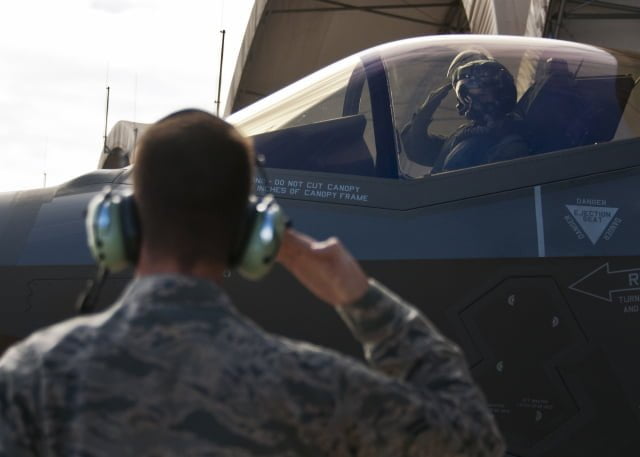2015-02-04 By Robbin Laird and Ed Timperlake
We had a chance to visit the USAF Warfare Center at Nellis AFB on the 15th and 16th of January.
On January 15th, we attended the ceremony for the arrival of the fifth F-35A at Nellis, but the first one fully configured for the planned initial operational capability for the USAF next year.
On January 16th, we had a chance to talk with the major command elements in this unique and significant command, which shapes the evolving combat Air Force and its complex combat choreography going forward.
These interviews complete our tour of the core warfare centers for the USN, USMC and the USAF and we will circle back in a later piece to talk about the impact of these interactive centers on shaping comprehensive dynamic change in U.S. combat capabilities.
The coming of the F-35A to Nellis means that the F-35 is now part of the re-shaping approach crafted by the USAF Warfare Center.
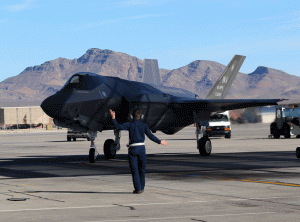
And this facilitated by the AWC being commanded by the first general officer to become a certified F-35 pilot.
The USAF Warfare Center is under the Air Combat Command, and the previous ACC Commander underscored how important it was for him to experience the F-22, and the impact of NOT fully understanding the aircraft in his earlier assignments.
Question: The last time we met, we learned that you had become the first ACC Commander to actually fly the F-22. We were impressed. From your perspective, how will the challenge of working the F-22s and the F-35s be worked with the legacy fleet?
General Hostage: You mean the Re-norming air operations if I were to steal a term?
Well, I was fortunate to fly the airplane, I learned what I didn’t know.
I was writing war plans in my previous job as a three star using the F-22s in a manner that was not going to get the most out of them that I could’ve because I didn’t truly understand the radical difference that the fifth gen could bring.
People focus on stealth as the determining factor or delineator of the fifth generation, it isn’t, it’s fusion. Fusion is what makes that platform so fundamentally different than anything else. And that’s why if anybody tries to tell you hey, I got a 4.5 airplane, a 4.8 airplane, don’t believe them. All that they’re talking about is RCS (Radar Cross Section).
Fusion is the fundamental delineator.
And you’re not going to put fusion into a fourth gen airplane because their avionic suites are not set up to be a fused platform. And fusion changes how you use the platform.
What I figured out is I would tell my Raptors, I don’t want a single airplane firing a single piece of ordinance until every other fourth gen airplane is Winchester. Because the SA right now that the fifth gen has is such a leveraging capability that I want my tactics set up to where my fourth gen expend their ordinance using the SA that the fifth gen provides, the fifth gen could then mop up, and then protect everybody coming in the next wave.
It’s radically changing how we fight on the battlefield.
Those radical changes are being worked out at the Air Warfare Center.
It is important to note that it is NOT called the Air Warfare Center but is Called the USAF Warfare Center, which is a recognition of the changing nature of warfare and the flexible multi-mission role of airpower in the 21st century battlespace.
Major General Jay Silveria is Commander, United States Air Force Warfare Center, Nellis Air Force Base, Nevada.
General Silveria grew up in an Air Force family and is a 1985 graduate of the U.S. Air Force Academy.
He completed undergraduate pilot training in 1986, and his subsequent flying assignments include positions as flight commander, chief of wing standardization and evaluation, and operations officer.
During his most recent assignment, General Silveria served as Vice Commander, 14 Air Force, Air Forces Strategic, at Vandenberg Air Force Base, California.
He has previously served as the Director, Security Assistance in the Office of Security Cooperation-Iraq.
The general has also served as aide-de-camp to the Supreme Allied Commander Europe and Commander, U.S. European Command.
He has commanded a fighter squadron and served as a deputy mission support group commander. Additionally, he commanded the 32nd Air and Space Operations Center at Ramstein Air Base, Germany, and 48th Fighter Wing, Royal Air Force Lakenheath, England.
General Silveria has flown combat sorties over the Balkans and Iraq and served as Vice Commander at Bagram Air Base in Afghanistan. He is a command pilot with more than 3,800 hours in the T-37, T-38, F-15C/E, HH-60 and F-35A aircraft.
The discussion with Major General Silveria focused on the role of the Warfare Center, the coming of the F-35 and the key role, which the center plays in shaping airpower integration, which is more correctly understood as “calibrated combat choreography.”
Question: What is the basic role of the Warfare Center?
Major General Silveria: At the Warfare Center, we do the three Ts: Testing, training, and tactics.
The Warfare Center owns the three Ts for the USAF.
The testing T is operational testing, not developmental testing. AFMC does the accession of weapons system.
Technological development goes through Edwards developmental testing. Then it arrives to us.
We’re going to test it in operational conditions, which lead to the integration piece.
How will the new aircraft or system work with the overall combat air force?
We test it in operational conditions, on the Nellis range, with experienced pilots in the most realistic conditions.
Developmental testers worry about things like:
- Is the software safe and does it do what the requirement side says and when the bomb comes off does it come off and separate properly from the airplane?
- Does the weapon hit the airplane?
- Does the weapon do damage to the airplane?
What we’re interested in is how quickly can I get through the operational mechanics of the airplane to drop the bomb?
Can I respond to a threat the way that it operates to release it and respond to a threat?
How does the play affect mission planning and impact on the other elements of the combat air force?
That is the testing part that we’re responsible for, namely operational testing.
Then the training is advanced training.
It’s Red Flag.
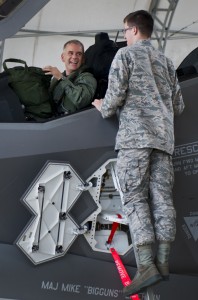
We do advanced training for operationally qualified squadrons when they show up at red flag and they go on the range against various threats, against aggressors, and at Green Flag operationally qualified crews work on evolving tactics for air-to-ground integration.
Weapons school is the gold standard for doing the advanced tactics for the combat air force.
You are going to visit the leadership of each of these elements, and they will deepen your understanding of each key element of what we do here at the Warfare Center.
The operational testing and the training lead to the tactics development that the warfare center is responsible for the combat air force.
Question: We learned at Fallon that the warfare center there worked on a regular basis with the deployed fleet and provided a kind of “consulting service” to the fleet to deliver updated tactics for problems in current areas of operations.
Does something similar happen here?
Major General Silveria: We work regularly with the air component commanders and help them with integration challenges or operational challenges they are facing in their area of operations.
And we feed back that work into the evolving tactics and training done here at the Warfare Center.
Question: Do you have a process as well to feedback squadron pilot lessons learned to shape innovation going forward?
Major General Silveria: We do.
Indeed, on another part of the Warfare Center right now you have a good example of the process.
We are hosting a weapons and tactics conference where we assemble in core areas, such as precision attack, ISR, or personnel recovery.
We assemble working groups from across the various platform groups across the USAF: We have an F-35 working group, and F-15E working group, and F-22 working group and so on.
The meetings allows the weapons officers and ops group commanders and squadron commander to gather in one place, to discuss the core tactical problems going forward and can then prioritize the tasks for the period ahead.
Then those Captains and Majors brief the 4-star generals to provide their recommendations.
The persons who are actually executing with the weapon system every day, who see the exact tactical problems, as always generate the real value for shaping a way ahead.
This provides a avenue for them to present that to the four-star General.
Then the four-star General whose responsibility is now resourcing and manning and staff energy can decide what to do in terms of resourcing or focusing training.
Question: Yesterday we talked with you briefly as the fifth F-35A landed at Nellis.
The first four are developmental test aircraft; the one that arrived yesterday is an operational test aircraft.
It is the plane which will go into the IOC inventory.
In effect, this plane is the entry card into the process of integrating the F-35 into the combat air force?
Major General Silveria: It is.
It is not a test airplane.
This is an airplane that is in the configuration that we’ll go to IOC with next year.
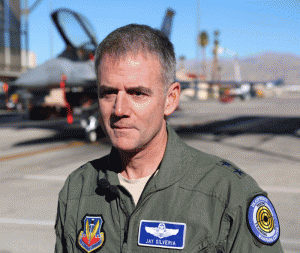
You met the pilot who flew into Nellis yesterday, Capt. Brent Golden.
He is an F-15E weapon school graduate who is now working on writing the first syllabus for the F-35 weapons school to be stood up in 2018.
There is another pilot currently down at Eglin who will come here and work with Brent to build that syllabus.
By 2017, we will have an initial class of instructors who will then validate the syllabus, and then it will be the foundation for training for the new F-35 weapons school.
Question: You are a certified F-35 pilot and fly the plane regularly.
What has been your experience with the plane and how to you explain the nature of the aircraft as a weapons system to those who have not?
Major General Silveria: Let me deal first of all with some of the fundamental differences which this aircraft poses and how those differences affect the way ahead.
A key aspect is the impact of numbers of aircraft.
The USAF will be the largest user of F-35s but we have many partners worldwide who are investing significantly in the aircraft.
Our ability to work together is going to be a fundamental aspect of shaping our working relationships going forward and helping one another to deal with difficult combat situations ahead.
The aircraft will demand a culture change, and understanding the adaptability of the aircraft is at the center of the culture change.
The aircraft is adaptable in many ways.
One way is simply the cockpit – you have very few switches and you have a blank screen that you can configure to the mission, which you are engaged in.
You will configure differently for air-to-air mission than close air support missions, for example, in terms of what you want to see on the glass in the cockpit.
When you first start to fly it you have a 20 by 8 touch screen.
You don’t have an air-to-air display, a radar, a targeting FLIR display, an instrument reading, an engine instruments, a radio frequency, an ILS display.
You don’t have any of that unless you want to see it.
And so you start with a blank page.
One of the things that’s interesting in training and it still goes on, is that the instructor who you first fly with will say, okay, here’s what you do.
You get four displays, I want you to take the right side make this one all one big display and then I want you to take this one and I want you to put the air-to-ground radar here and I want you to put the targeting fleer here and I want you to put the air-to-air radar over here.
And down on the bottom of this one put the weapon one and the other, you know, the air-to-service weapon and then I want you to put the air-to-air weapon here. And okay, go.
So there are you are flying because that’s what your instructor told you to do.
And then you start to realize that you can configure to your preferences.
I’ll do a full screen here and then when I’m in a air-to-ground role I’m going to expand my air-to-ground and it’s going to take up this whole side because I want it bigger and I want to be able to pick out the little part of the radar that I’m trying to target.
The air-to-air display will have this element, this element, and the another element.
It will show me the electronic emissions that are in the air, but when I go to air-to-surface mode I don’t want to see all that so I’ll change what appears on the screen.
What’s interesting is when you get in to the debrief, you can see people’s how they do a displays tape and they’re all different.
Question: So one aspect of adaptability is clearly the pilot able to configure the screens to support the missions. In what other ways should one think about adaptability?
Major General Silveria: Clearly, a key aspect of the F-35 is software upgradability.
This provides both for growth potential but a significantly different way to operate.
And this is difficult for people to grasp who do not fly the aircraft.
One aspect associated with both fusion and software upgradeability is that the F-35 is an integrated weapons system.
Many articles are written criticizing this or that particular system on the aircraft; but this aircraft is not really about this or that system; it is about the capability of a diversity of system to work together to deliver an effect and overall capabilities.
Another aspect is what software eliminates from the aircraft and allows for enhanced combat effectiveness.
A key example is the CNI system.
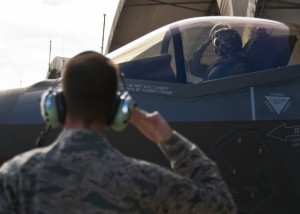
The plane has NONE of the items that traditionally on airplanes to transmit and receive. It does not have any of those.
What it has is a rack two CNI (Combat, Navigation and Identification),com ad navigation racks.
It has two racks and you tell the airplane: I would like to transmit in the UHF wave form and it generates that wave form and transmits in the UHF wave form; which is a difficult concept to think about.
There is no UHF radio on the airplane.
There is no ILS on the airplane.
If I want an ILS I have to go in, tap on my glass, and say, hey, good morning jet, I’m going to need an ILS today so I need you to generate the ILS waveform when I need it.
What does this mean in terms of performance and maintainability?
I do not have to maintain what is not there; I do not need to be affected by failure rates of systems that are no longer there.
Let me use the example of the IFF transponder, which I do not have on the plane as a separate system. On an F-15 E, you can walk to the ramp and open up a panel and you can find a little box that has all sorts of cannon plugs on it and it would say ITT transponder.
And if it fails during the operation, when you come back you tell maintenance, it does not work.
They’d undue the cannon plugs, they’d pull out this IFF, they’d send it to the back shop, they’d go through all the testing, they’d figure out, they’d fix it, and it would come back.
They would put another one in. Well, this airplane doesn’t have that to either fail or to fix.
Question: What is the role of the initial service to deploy the aircraft, the USMC and your dealings as well with the F-35 partners as the Warfare Center shapes a way ahead for the combat air force?
Major General Silveria: A key aspect of the F-35 notably as a fleet is its ability not only to fuse data but to communicate that data to other F-35s and via link 16 provide greater situational awareness and targeting information for legacy aircraft.
But less known is the key role of correlating the sensors with the mission data files correlated with the F-35 fleet.
The mission file is built around the operational intelligence mission data.
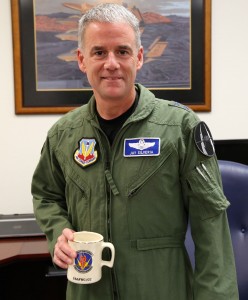
The mission file includes all of the data about every threat, aircraft, surface-to-air missile, blue aircraft, airliner, whatever that airplane may see during its flights.
That intel mission data will fill the mission data file that will build is what the airplane then goes in and looks to see when it fuses that target.
The mission data file that we’re building right now in the 513th at the 53rd wing which are part of the Warfare Center were initially building are for the Marines. Our guys are building that mission data file.
The real value here is that we’re all going to be working off that same mission data library.
This means that the Marines will go first and as they operate their aircraft their operational intelligence data will flow into “our” mission data file.
That is a whole different meaning to joint.
And then there is the coalition piece.
When I trained to fly the F-35 at Eglin, there were Dutch, Navy, Marine Corps, British and Air Force pilots in the group. We were all co-mingled.
When I go to Edwards and fly with my test squadron, there are Aussies, Brits and Marines there as well.
This is unprecedented.
This is the just the beginning of the operational use of the aircraft and we are sharing operational experience from the ground up on the joint and coalition level.
We are stirring the pot from the very beginning of the program.
Question: How does the Warfare Center approach integration of a new aircraft such as the F-35 into the combat air force?
Major General Silveria: Integration is what we do here at the Warfare Center.
We are the only place you will find F-16s, F-15Es, B-1s, B-2s, RPAs, AWACS, and F-22s working together in common tactics and training being tested in real world Red Flag or Green Flag exercises.
But the term integration can be confusing because it really is about the evolving capabilities of the combat air force going forward and to shape the combat choreography of many moving parts to shape the effects you want to achieve with airpower.
And with the F-22 to date and with the F-35 entering the combat air force, it is about how legacy aircraft can adjust to the new capabilities and the combat team learn how to use both the legacy and the new aircraft more effectively together.
For example, with regard to the F-22, which is by now an aircraft well integrated into our combat choreography, we have learned that the situational awareness and information dominance, which it brings to combat, has made the legacy aircraft more lethal and survivable.
And we have seen with the F-22, that with its information dominance capabilities, there is a clear advantage of these aircraft providing information to enable legacy aircraft to fire their weapons much more effectively at core targets.
For example, the F15Cs now have learned what they get from the F22s.
And so now they are certain things they won’t try to do because they know they’re going to get that in from the F22.
We have to teach the fourth gen at the same time we’re learning about the capabilities from the fifth generation aircraft.
The F-35 will enter directly into that world; we will learn what the F-35 provides and how legacy aircraft can become more lethal and survivable.
And we will learn whole new ways to operate as the F-22s and F-35s operate together, indeed we have already started that operational testing at Eglin.
There is an interesting aspect of the F-35 coming to the force which should not be ignored – we have pilots from a diversity of backgrounds, and these pilots are bringing those different cultures to the aircraft.
I fly with the 422nd and when I go into the F35 division of the squadron there’s an A10 pilot, an F16 pilot, and F15E pilot; there are a broad mix of different platforms in that F35 division.
This can bring the F-15E interdiction mindset, along with the A10 attack mindset, the F-16SEAD mindset.
With those cultures blending and with our ability to tap into our F-22 squadrons to bring the LO and information dominance mindset in as well, we are well positioned to shape an F-35 transition.
The process is complex; but at the Warfare Center we are working on helping shape the evolving combat air force, and to ensure that the combat choreography leverages what we can deploy now but anticipates where we can go next.
For a PDF of this article please go to the following:
Major General Silveria Interview January 2015
Credit Video: DoD News, 1/20/15


